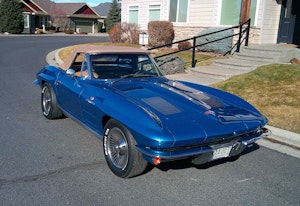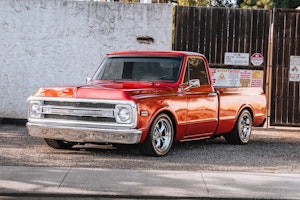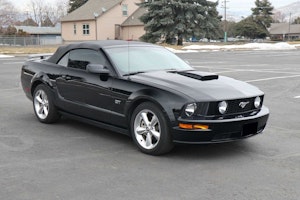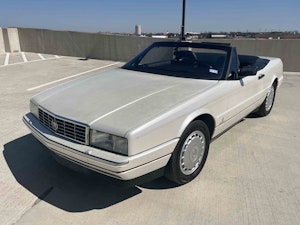Media | Articles
Volkswagen ID.Buzz First Drive: This Jumbo, Retro EV Could Make Vans Cool Again
Hey, Jude, look what’s rocketing out of the purple haze on an interstellar trip! It’s the coolest magic carpet ride since Haight met Ashbury, baby! This bus is so…bus-like that it’ll haul all your little green apples to Woodstock, and everyone’s welcome to take a free ride. So take a load off, Fanny (yes, it is Fanny in the song, but Annie is welcome, too), and climb aboard, there ain’t no mountain high enough, no bridges over troubled waters, no rainy nights in Georgia that will keep a green-eyed lady from taking the long and winding road!
Or something like that. Get ready for VW to lay on the ‘60s schtick with a front-end loader as the ID.Buzz rolls into showrooms this November. However, at the end of the day, when all the two-toning and tie-dying and lava-lamping is over, what you have in the 2025 ID.Buzz is a 6000-pound three-row electric motorcoach that offers Chevy Suburban-like interior space in a box about the length of a Honda Accord. For $60,000-$70,000. We never said nostalgia is free.

Throughout its long and occasionally stormy sojourn in America, Volkswagen has developed a knack for both delighting and disappointing us in equal extremes. About every third generation of the Golf is sublime, practically near perfection. Then it’s scrubbed for a couple of flabby and forgettable replacements. Too many botched opportunities to recount here have led VW to label itself “a small player” in our massive and highly lucrative market, despite VW currently ranking as the world’s second-largest automaker with a production rate of more than 25,000 vehicles daily.
The volks at Volkswagen hope to change all that with an electric bus—really, this is the best word to describe it—that is one part retro to three parts ultra-modern fashion accessory. It’s expected to pull drivers mainly out of mid- and large-size SUVs, and draw many newcomers to the brand. It has a lot of hopes riding on it.

First, the basics: Three trim levels offer buyers a choice of varying luxury levels and rear-drive or all-wheel-drive, with a 91-kW/hr battery as the only battery available and up to 200 kW/hr in fast-charge capability. Which is good because this 1230-pound battery supplies an EPA range of only around 230 miles, meaning the bus drinks the electrons at a pretty healthy rate.
Marketplace
Buy and sell classics with confidence

The $61,545 Pro S is the starter model. It includes plenty of standard nice-to-haves in a van, such as power sliding doors and a power tailgate, heated and vented front power seats, heated steering wheel, the usual wireless connectivity, no fewer than eight USB-C ports, parking assistance, and so on. It’s a long list, VW clearly figuring that most people will want all this stuff anyway and the ones who don’t will probably buy the car regardless.
If you want the front-axle motor that supplies all-wheel-drive capability, or the very snazzy two-tone paint which is available in eight combinations, you must step up to the Pro S Plus, which is either $65,045 in rear-drive form or $69,545 as a 4Motion. Among other frills, it adds a Harman Kardan 14-speaker audio system. Oh, the two-tone paint is another $995 (this trim level just gives you access to that option) and at this level you can also option the $1495 panoramic glass roof. We did say this market is profitable; VW figures the Pro S Plus to be the volume model. Finally there’s the range-topping 1st Edition, a one-year trim that tops out at $71,545 as a 4Motion. It includes the glass roof and two-tone paint plus some fancy badging and wheels.

Those wishing the Buzz looked more like the original T1-T3 generations of VW busses can forget about it; that shipped sailed decades ago when crash standards required that the driver be moved behind the front axle. Nobody who actually experienced their knees serving as part of the crumple zone in a front-ender misses those designs. The company continued to sell vans globally after yanking them from the U.S. in 2003. Of the 22-year hiatus (we’re deliberately not counting the Chrysler-sourced Routan), the company believes, according to ID.Buzz senior product planner Ryan Gavin, that “we took our time to find the right product.” They did indeed.
Specs: 2025 Volkswagen ID.Buzz
- Price: $61,454-$71,545
- Powertrain: AC permanent magnet synchronous motor, rear or all-wheel-drive
- Output: 282-335 hp; 413-512 lb-ft
- Layout: rear-motor, five-door, rear- or all-wheel-drive van
- 0–60 mph: 4.7 seconds (estimate)
- Competitors: Chrysler Pacifica, Toyota Sienna, Rivian R1S, Chevrolet Suburban

To give the Buzz a flatter face more evocative of the old models, the windshield has been pushed forward to create the mother of all dashboards, which gives one the feeling of driving a greenhouse from the back wall. A veritable Hurtgen Forest of pillars brackets the windshield and corner windows, creating some blind spots for pedestrians and other slim objects to hide in (a motorcycle or even a compact car coming at you at just the right angle definitely qualifies). Fortunately, there are object-detection sensors for the front, but even so, drive the Buzz with a sharp eye toward the front corners.
The exterior speaks for itself; the interior of the U.S. versions approaches luxury car levels despite being upholstered in “leatherette” which, granted, is soft and deluxe feeling and could fool just about anyone. The interior motif is not retro at all, the smooth surfaces flowing together organically and punctuated by soft-touch color insets of a technical synthetic. The floor mats are high-spec and resemble CoCo mats in vintage Porsches. Three interiors are offered, dubbed “Dune,” “Copper,” and “Moonlight.” Or, put another way, light, dark, and darker. All are attractive and you’d hate the thought of seeing them after a year with kids aboard. We drove the Dune and found its bright and airy feeling to be a refreshing break from the dismal black coal shafts installed in many cars these days. Business-class comfort and legroom are to be found in the middle and even the third row thanks to the Buzz’s excellent use of its interior space.


The trouble is in operating the heat-sensitive finger-slider controls and the heinously inept user interface for the 12.9-inch central touchscreen. Veterans of the Buzz’s smaller sister, the ID.4, are already familiar with goony design choices such as there being no separate window switches on the driver’s door for the rear windows (the Buzz has electrically sliding windows within its side-door windows). Instead, there is just a single pair of window switches on the driver’s door, plus a touch-sensitive mode-select button to tell the car whether you intend to open the front or rear windows. When did window switches require mode buttons? It’s madness.

For what is basically a minivan, the ID.Buzz lacks a few minivan basics. The center row, whether it be a bench or optional captain’s chairs, neither folds into the floor (there’s a battery in the way) or is removable, so the Buzz can’t strip all the way down to its floor to go full cargo mode. Instead, an optional elevated platform in back called a “Flexboard” creates a flat floor across the folded rear and middle seats, which will be fine for hauling a few sheets of plywood but might not leave enough room to move a kid to college. Also, there’s a shortage of clutter space between the seats and no cupholders for the middle row. Modern vans are all about clutter and cupholders. A shelf in the dash in front of the front passenger does allow more acreage for cell phones, iPads, cords, cinnamon-apple pouches, etc.

You sit up high and have a commanding view forward in the Buzz, at least between the blind spots. For a vehicle that checks in at 6000 pounds, it moves off the line with a vigorous start and has no trouble keeping pace with traffic or even scooting into opportunistic holes. The horsepower ratings are 282 for rear-drive, 335 for the 4Motion, with 413 pound-feet of torque from the main rear motor and 99 from the front, if you opt for it. The towing capacity ranges from 1650 for the rear-drive model to 3500 for the 4Motion, with a nifty retractable hitch available as a dealer accessory.
The ride is compliant, which isn’t always the case with electrics carrying a lot of mass in their bellies and needing firm suspensions to control the wheel movement and stiff sidewalls on stiff tires for minimum rolling resistance and maximum range. By contrast, the Buzz never felt harsh over the bumps, partly a credit to its extremely long wheelbase. The steering responds well, indeed, better than the brakes, which we found to be a bit soft and lacking bite. A regen paddle à la GM’s EVs would help; max regen when you want it would help take the load off the brakes. As it is, unless you’re in the Battery mode, which locks it in max regen, the regen feels almost nonexistent. GM is to be celebrated for giving drivers absolute control over regen levels.

While the Buzz is relatively short for its copious interior space, it is no Micro Buzz. It’s rather wide at 78.1 inches, only about three inches narrower than a Suburban, and we foresee garage-ability as potentially being an issue for some owners. Unfortunately, VW has decided not to bring us the shorter two-row Buzz available in Europe, nor the cargo version, so the Macro Buzz will have to do. It’ll certainly create a buzz for Volkswagen initially, but only time will tell if it has the staying power of the original Bus.
2025 Volkswagen ID.Buzz
Highs: Comes pretty loaded in all trims, spacious inside, looks and feels thoroughly modern and luxurious, scoots hard when you need it to, something different in a sea of sameness.
Lows: Starts at $60k, not much range for the size of the battery, only comes in size XXL, have to option up for some of the goodies like two-tone paint, maddening electronics.
Summary: The ID.Buzz is more forward looking than retro and more fashion accessory than hard-core family minivan, but it is undeniably cool and a smarter choice than some of the jumbo SUVs it competes against.



























Two notes:
-Please, type “bussy” into Google or Urban Dictionary and re-consider using that term in your article.
-The price on these is insane for the actual range you get. They stick STARTING at 81k in Canada.
My Niro EV averages 4 miles per KWH. batteries has about 65KWH+ capacity.
“The $61,545 Pro S is the starter model.” For THAT? No thanks…
What is the range for each model?
The article stated only one battery was available, with a range of 230 miles. The luxury versions might have a bit more weight and/or power hungry options, but probably doesn’t reduce range much, if any.
No thanks, I’ll pass.
I can have a whole lot more fun with $70k than with this contraption…..not to mention return on investment…..
when will the internal combustion engine be available?
An aftermarket business will be born … converting these to ICE Camper Vans.
Now, if it was ICE OR HYBRID powered and priced like a traditional minivan, THAT would interest me.
It won’t interest you, then. The platform is incapable of holding the parts required to do so.
Agree: Electric? No thanks.
Can we expect traditional VW quality and reliability…like we had on the “New Beetle”?
Will it be built in Mexico? If not, where?
Just like practically all EVs now, after the initial “Gotta have one” purchases occur, this thing’s sales, too, will tank.
I drove a demo short wheelbase version at the VW Factory in Wolfsburg, Germany in May of 2023.
My takeaway of that one was: SUV with an extended cabin nose. I think they made the right call by only offering the extended wheelbase here in the land of rolling fortresses, but I believe I’ll hold onto my 2002 Eurovan Multivan Pop-Top Weekender and 1985 Vanagon Weekender. We still use those every summer for weekend Bluegrass Festival camping.
Totally lost me at “middle seats can’t be removed.” I use my 12 year old minivan as a camper and a cargo hauler. If I can’t replace those two capabilities I’m not interested.
It will have a following but I think what you get for your $60-$70k isn’t enough to justify a purchase.
Last year when I was returning my VW iRock to the rental company in S France I parked next to one of 3 VW Buzz’s. Yes they are shorter but what I found most interesting is that they were outfitted much like the old Type 2 Kombi’s. Simple mid and rear seats with simple door cards. If VW would import the panel version….if only
Make it a plug in hybrid with a honda civic like 4 cylinder engine…. and cover the roof in flexible solar cells. Now that would be ineteresting.
My local dealer confirmed 90K Canadian dollars for the 4 wheel drive and the 2 tone paint! After the initial shock I had to remember a Dark horse Mustang, Jeep Rubicon, Nissan 400Z Nismo, Supra, Bronco Heritage (Even more), Corvette, are all around 80-90K (Canadian), so I guess its in the range for the cool kid cars!
Will see if the take rate continues past year 2.
Definitely not an Economy Vehicle–nor does it propose to be The Peoples’ Vehicle–where Average Joe could do repairs at home, the side of the road or in a neighbor’s backyard. VW never will restore the “confidence” which it once installed into each and every VW Purchaser!